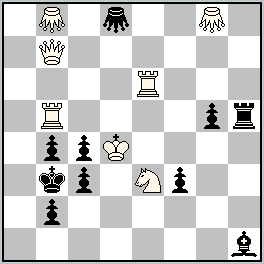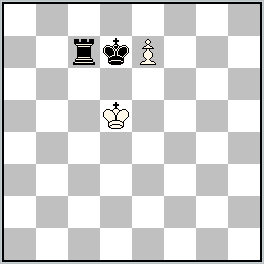|
|
Updates as of 21-May-2012:
|
Ideas with KoBul Kings
 |
May, 2012Ideas with KoBul KingsI’d like to present you 4 fairy problems with KoBul Kings, all composed in 2012 for the KoBulChess-TT-2012 (see the Award at kobulchess.com – by Diyan Kostandinov, the innovator of KoBul Kings).
KoBul Kings – When a piece (not a pawn) of its own side is captured, a King transforms into a Royal piece of the same type as the captured one. When the King is in the form of any Royal piece and there is a capture of one of the pawns of its own side, it becomes a normal King again. Сaptures are illegal if their result is self-cheсk because of the transformation of the Кings according to KoBul rules. Castling is allowed only if the KoBul King is on its initial square in the form of a normal King and if it has not already moved; however it may already have been transformed. In the case of capture by a King in AntiCirce it reborns on its initial square and may castle. If the capture is by a King which is in the form of some Royal piece, it reborns on the initial square of that piece.
|
In the problems below I wanted to show the different ideas I’ve got after studying the examples of KoBul Kings. Few words about them:
- No.1 (h#2) – just 5 pieces and 2 solutions! The advantage of Kings’ transformation which gave more possibilities to the white King to attack and less possibilities to the black King to defend. Composed in less than an hour – the most “quick” problem I ever had. Light and easy.
- No.2 (hs#3) – the main thing I wanted to show was how the only possible defense of the white King – capture of the mating piece – fails because it transforms the black King into a piece which gives a check to the white King again.
- No.3 (h#2,5*) – another “paradoxical” situation with KoBul Kings: how the white pawn, which occupies the square, can guard this square? – normally impossible thing!
- No.4 (h#2,5) – joint problem with Petko A.Petkov, who’s helped me a lot with learning Locusts’ behaviour. The battery play and activity of the both KoBul Kings.
|
No.1 Julia Vysotska
KoBulChess-TT-2012
1st Hon.mention
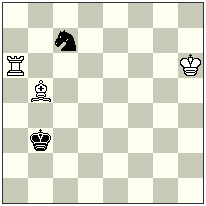 h#2 2 solutions (3+2) h#2 2 solutions (3+2)KoBul Kings
–
I. 1.Sxa6(wK=rR)! Bd3 2.Ka3 rRxa6 (bK=rS)#
II. 1.Sxb5(wK=rB)! rBe3 2.Sa3 Rxa3 (bK=rS)#
–
Activity of both Kobul Kings:
– the phases of white King are changed with the Captures of white R and B; – the phases of black King are changed with the passive and active sacrifices of black S. 5-men problem – aristokrat with ideal mates. |
No. 2 Julia Vysotska
KoBulChess-TT-2012
2nd Prize
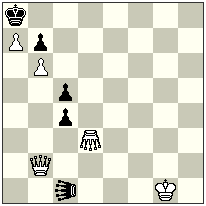 hs#3 2 solutions (5+5) hs#3 2 solutions (5+5)KoBul Kings
White Grasshopper d3
Black Leo c1
–
I. 1.Qd4 cxd4 [wrK=rQ] 2.rQd1 LEd2 3.Gd5 + LExd5 [wrQ=rG] #
– not 4.rGxd5(bK= brLE)?? – self-check!!
II.1.Qb3 cxb3 [wrK=rQ] 2.rQg3 LEe3 3.Ga3 + LExa3 [wrQ=rG] #
– not 4.rGxa3(bK= brLE)?? – self-check!!
–
Realization of the KoBul fairy condition with activity of the both KoBul Kings:
– Active phase of the white KoBul King after sacrifice of the white Q – transformation to the Royal Q, which moves to the mating positions.
– Passive phase of the white Kobul King on the mating move – transformation to the Royal G, which has no possible moves to avoid the mate.
– Passive phase of the black KoBul King – the only possible defense of the white King (in the Royal G phase) – capture of the mating piece (bLE) – fails because it transforms the black King into Royal LE piece giving the self-check.
Double Ambush – black (Le) + white (rQ);
Bristol theme – wG opens lines for the second moves of bLE; ODT; Model mates.
–
|
|
No.3 Julia Vysotska
Julia’sFairies-2012
–
 h#2,5* (3+4) h#2,5* (3+4)KoBul Kings
–
1… … 2.Sf7 f5 3.Bf4 rSxf4 [brK=rB] #
– not 4.rBxf3(wrS=wK)?? – self-check!! 1…rSd4 2.Sg4 rSf5 3.Bf6 fxg4 [brK=rS] #
– not 4.rSxf4(wrS=wK)?? – self-check!! –
The black King in the rB/rS phases can’t capture the white pawns f3/f4 because it transforms white rS into the King phase giving the self-check. Sacrifices of the black S/B with the transformation of the black King.
|
No. 4 Julia Vysotska & Petko A.Petkov
KoBulChess-TT-2012
3rd Prize
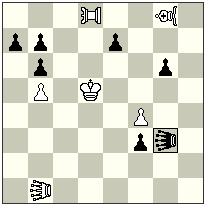 h#2,5 2 solutions (6+7) h#2,5 2 solutions (6+7)KoBul Kings
Rook locust d8; Bishop locust g8
Leo b1, g3
–
I. 1…LEd3 + 2.rLExd3 [wrK=rLE] rLEd7 3.rLEd6 rLExa7 [brLE=rK] #
II. 1…LEb3 + 2.rLExb3 [wrK=rLE] rLEf7 3.rLEe6 rLExf3 [brLE=rK] #
–
Activity of the both KoBul Kings:
– Sacrifice of the white LE to the black Royal LE changes the phase of the white King to rLE, then is created a WHITE BLACK Bristol LEO –LEO! – Battery play (direct and indirect) with the white King in LE phase with the simultaneous capturing of the black pawn for changing the phase of the black King from rLE to K and controlling the squares of the black King. –
|
Site Updates-180512
|
|
Updates as of 18-May-2012:
|
Julia’s Fairies – HSP – 2012
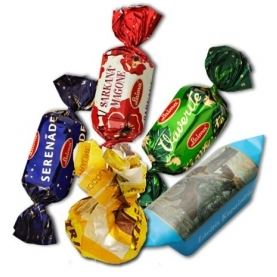 |
|
RULES: Help-self problems (HSP) of any possible types: Help-self mates (HS#), HS=, HS==, HR#, HR=, etc. in any number of moves.
THEME: Battery-play with fairy elements
- All pieces (white, black, neutral, half-neutral, etc) and conditions are allowed!
- The thematic “Fairy element” (pieces, conditions) should be demonstrated in play at least in one battery or (plus) anti-battery of any type.
- The problems should be computer-tested.
 JUDGE: IGM Petko A. Petkov – International Judge of FIDE
JUDGE: IGM Petko A. Petkov – International Judge of FIDE

Please send your originals until the 15th of October, 2012 to the Tournament director and editor of Julia’s Fairies site – Julia Vysotska, e-mail: julia@juliasfairies.com
The Award will be published at the site in December, 2012.
Special Present from Julia’s Fairies
to the 1st, 2nd, 3rd Prizes: Selection of Latvian sweets!
Examples:
|
N 1.Petko A. PETKOV The Macedonian Problemist 2003 |
N 1: 1.Rxg5 f2 2.Ra5 Bxb7 3.Re4+ Rd5#; 1.Qxf3 g4 2.Qa8 Rxb5 3.Re5+ Bd5# Fairy elements: white direct battery created by Re6 (forward piece) and Gg8 (rear fairy-piece); black anti-batteries – Bd5/Gd8 and Rd5/Gd8. Any anti-battery is always thematic as “fairy element”. |
|
N 2. Wilfried SEEHOFER feenschach 2008
|
N 2: 1.e8=R Rc8 2.Re1 Re8 3.Kd6 Kc6 4.Rb1+ Re1# Fairy element – creation and play of two Anti-Circe genre specific batteries (some authors call them Ecto-batteries) – white battery Re1/Kd6 and black battery Re8/Kc6. After play of Rooks (as forward pieces) two Kings are activated and give check (mate). A good example of fairy-battery which is created by orthodox pieces only, but which demonstrates fairy-element according to the rules of condition Anti-Circe! |
Good luck to everybody!
Site Updates-140512
|
|
Updates as of 14-May-2012:
|
Site Updates-120512
|
|
Updates as of 12-May-2012:
|
Site Updates-110512
|
|
Updates as of 09-11-May-2012:
|
1st month!
|
|
10-May-2012
|
Block of Neutral Battery Piece – II
 |
BLOCK OF NEUTRAL BATTERY-PIECE(Part II)IGM PETKO PETKOV |
 |
See Part I in the Theoretical Articles Category
III. WORK WITH LOCUSTS
Why we should pay a special attention to the Locust fairy piece, developing our main theme? Indeed, some examples were already shown in the first part of this article!
My answer is: although the Locust is not a new piece (its modifications, like Rook-Locust, Bishop-Locust etc. are well know in practice), I think that there’re arguments for even more complete examination of this piece in relation to this topic. More specifically:
a) We are talking about neutral Locusts, but the are not much used in practice, when the problems don’t contain any additional fairy conditions.
b) Many effects of these pieces are little known, and some of them, which will be discussed later, perhaps are very little used, or even never met until now.
c) In some modern genres – for example, HS# or HS= fairy problems, neutral Locusts are still poorly used and there is a huge practical reserve.
d) In theoretical approach it is interesting to examine a number of issues here, that are not clarified in the theory of fairy problems, meaning in reality, that the term “theory” is very relative in this arena. It is well known, that up to now such a theory – in a form of a serious, complete scientific and practical work – doesn’t actually exist.
e) The central theme of this article – block of neutral battery piece – has a particular importance, since exactly this motif, as it was already mentioned, interferes with the side which gets mate, to protect itself by escaping a neutral piece, which we have named “X”.
f) Since this article has a strong practical emphasis and is also planned for the wide range of readers, especially – beginners, many motifs here are explained with only a simple diagrams, which demonstrate the important basic effects the readers can apply in their work.
So, let’s continue with the series of examples, where Locust is a forward piece or rear piece in a different batteries or anti-batteries.
As a forward piece, neutral Locust can demonstrate an interesting effects – it opens the battery, but at the same time the side which is in defense captures the rear piece with the same neutral Locust and the goal can’t be reached immediately. Thus, blocking of piece “X” which is implemented by the own piece or by the piece of the other side, prevents the piece “X” from the capturing of the rear battery piece, destructing the battery. One such an example you’re already seen in the part I – problem No.6 – a fairy twomover, where “X” acted as a forward piece in the direct battery, but in No.7 – as a forward piece in the anti-battery, although there was just one solution.
Let’s continue a little bit with the examples of this type.
No.9. Petko A.Petkov
Educational example
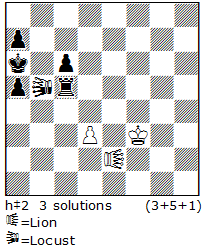
In No.9 we can see that the battery is going to play. The battery is created by the following pieces: nLOb5 – forward piece, LIe2 – rear piece, Pd3 – a pawn, which has only technical functions from the first view, although without it it would be impossible to create our battery. At the beginning let’s try this idea for the solution: 1.Rc3 ~ 2.Rb3 nLOxb3-b2+? – but here we see already known defense by the black: 3.nLOxe2-f2+! – capturing the battery-piece LIe2.
It’s not difficult to guess, that white (for now we haven’t defined their first move) can block the square f2 — and everything will be fine. Thus we have: I. 1.Rc3! Kf2! 2.Rb3 nLOxb3-b2#! But the problem has 3 solutions — let’s see what’s going on.
Analogical ideas by the black Rook we can implement also with the moves: 1.Rc4 1.Rc2. But suddenly, the very important role here has exactly our pawn on d3!
First, let’s try: 1.Rc4 ~ 2. Rb4 nLOxb4-b3+? but 3. nLOxd3!! – white battery doesn’t exist anymore as the pawn d3, which is needed in this construction, is removed, and there’s no mate! Therefore we should here also block the square e3 with a white by analogy with the first solution, to make impossible a capture on d3: II. 1.Rc4 Ke3! 2. Rb4 nLOxb4-b3#! Analogically: III. 1.Rc2 Ke4! 2. Rb2 nLOxb2-b1#! – again the white King has blocked the square for the neutral Locust!
Now it’s a time to speak again about the white pawn, which participates in the creation of white battery, but is not named yet. Of course, any names are possible and it is not that important from the practical view. Let’s name it tool battery-piece or shortly TBP.
The conclusion we have here is:
а) Pieces and pawn of TBP type – can be often found in a batteries, where a fairy pieces of Нoppers type participate in a battery creation. In case of direct battery creation with a Hopper rear piece, almost always the TBP pieces are applied and in most cases they are pawns – of one or another color.
b) Usually, such kind of pieces in most of problems neither do any move, nor are captured. In the other words, they’re pretty static.
c) In which casesTBP-piece is considered as a bad piece in a problem? In case if TBP is a pawn, such a question is almost never worth. Another case, if white or black piece acts as a TBP. Then the actual question is – if this a piece, although needed in the battery construction, does it stay well on the board?
My answer is the following: if TBP is a piece, not a pawn, then it stays a little bit bad on the board in case if it acts only as a technical element of the battery. Therefore, we should try to add some additional, thematic or incidental function to our TBP! This is very important from the aestetic point of view!
For example, in our studied problem No.8 – the white Sd8 acts as TBP. But it is not a bad piece, as it has also the additional function – it guards the important square b7!
A better usage of TBP is shown in problem No.9, where pd3 acts as a TBP, and the play in 2 solutions is based exactly on the impossibility of capturing this piece!
Of course, in No.9 it is possible to remove one of the solutions and, replacing black Rook with a Bishop for example, to compose a version with just two solutions, where the blocks are done only by the white King next to the TBP-pawn. Thus, we got the scheme No.10: 1.Be5 Ke4 2.Bb2 nLOxb2-b1#; 1.Bd6 Ke3 2.Bb4 nLOxb4-b3#. By the way, here (like in No.9 as well) a Bishop-Lion also can act as a white rear piece.
No.10. Scheme
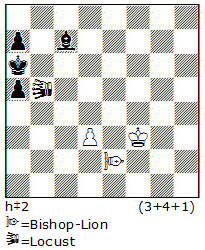
Now let’s look at some special cases, where two neutral Locusts are on the thematic battery line.
According to the battery rear piece, two neutral Locusts can create the following batteries, which deserve a special attention:
А) Direct battery with two forward pieces
B) Special battery with two forward pieces
C) Half-battery with two forward pieces
D) Special anti-batteries
Let’s look at the typical schemes:
A) Direct battery with two forward pieces
In a scheme No.11 a thematic battery consists of 3 pieces: forward pieces –nLOf3 nLOd5, rear piece – Lion a8. Of course, it is possible here to use some other piece of Hoppers type on the square a8: LEO,VAO, Bishop Lion etc.
It is important to emphasize: it is not a half-battery, but exactly just a battery, but with two forward pieces X! Why it’s not a half-battery? Very simple – because in case of half-batteries the both forward pieces play. But here such a moment doesn’t exist – every time only one of the forward pieces plays, but at the same time the other one acts like TBP; in the second solution the pieces interchange their functions.
No.11. Scheme
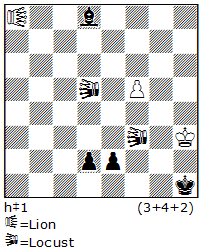
So, let’s try to give a mate in 1 move in No.11: 1… nLOxe2-d1+?n – using the piece nLOf3 as a forward piece. This try doesn’t work, because a black answers with the move of another piece along the battery-line – 2.nLOxf5 – g5! and the battery is distructed. The analogical try is: 1…nLOxd2-d1+? but 1…nLOxf5-f6! and the battery is distructed again.
To realize H#1 is only possible blocking the squares g5/f6. Thus, a static Locust in a role of TBP-piece doesn’t have anymore an opportunity to capture the white pawn and to destruct the battery: 1.Bg5 nLOxe2-d1#; 1.Bf6 nLOnxd2-d1#.
It’s even more interesting, when during a play the both neutral Locusts are blocked, as it is shown in a problem No.12.
It’s not difficult to see, what kind of plan should be implemented here: the black Queen is sacrificed with the aim to give an opportunity for the neutral Locusts to move on vertical g. This way they give double checks with a mate.
But in the initial position it’s impossible to realize this idea. Let’s try: 1.Qf3? nLOxf3++? – now black has 2 defenses from the mate: 2.nLOcxg2-h2! and 2.nLOgxc2-b2! Analogically, the following try doesn’t lead to the goal: 1.Qf2? nLOxf2-g2++? – again black has 2 defenses from the mate: 2.nLOеxg2-h1! and 2.nLOgxe4-d5!
No.12. Petko A.Petkov
original
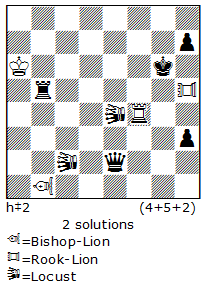
A plan for the solution consists of the following: to give a mate in the both solutions every time we should block two squares. These blocks by the black and white pieces are done this way: I.1.Qf3! RLh2! 2.Rb2! nLOxf3-g2#! – here h2 is blocked by white, and b2 is blocked by black; II.1.Qf2! RLh1! 2.Rd5! nLOxf2-g2#! – here h1 is blocked by white, and d5 is blocked by black.
A block of two thematic Locusts is a very nice interpretation of the theme, but it is always good if a problem has also some more interesting motives. Here they are: a) sacrifice of a black piece (it’s almost a standard motive in such a schemes); b) destuction of a black battery R/Q – the very important and interesting idea, which define the order of the black moves!
Of course, it’s possible to use some other similar batteries with the analogical location of Locusts, as the scheme No.13 shows. Here in the upper part of the position a NAO piece is used as a battery rear-piece – a very important piece in this role! In the lower part of the position a battery which can be used in help-self mates is shown.
No.13. Scheme
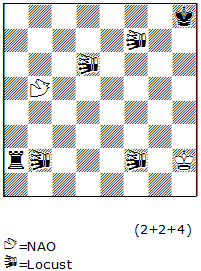
Very often, using modifications of the standard (Queen-type) Locust – like Rook-Locust, Bishop-Locust etc. – it is possible to compose an interesting problems of different fairy genres.
A typical example is No.14: Set-play: 1…nSe5+! 2.RLOxe5-f5 Kf2! 3.Rd5 BLOxf5-g6#; Real play: 1.nSe7 nSd5! 2.RLOxd5-e5 Kg2! 3.Rc5 BLOxe5-f6#. Thematic complex here includes also non-standard motives: sacrifice of a neutral S, sacrifice of a black Rook-Locust, Bristol-theme RLO-R, black blocks.
No.14. Petko A.Petkov
original
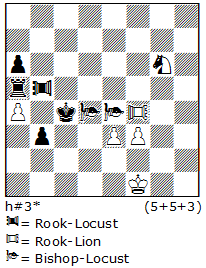
B) Special battery with two forward pieces
Please look at the diagram No.15 – at the first glance, a very familiar, easy position. And yet, here’s something very interesting and different to the previous examples in the section A). A stipulation #1 is realised here in a very peculiar (original) way: 1. nLOxe5-f6#! 1.nLOxd4-c3#!
No.15. Scheme
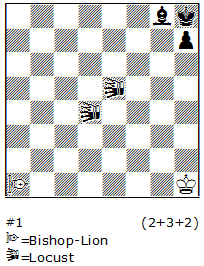
THE FIRST QUESTION: What’s this? Is this a direct battery, half-battery or anti-battery play?
My answer is: Here we have a play of a battery of a special type – with 2 forward pieces. But the piece which gives mate here, captures another forward piece and it is implemented along the battery-line with the Annihilation method! As a forward piece here we can consider a piece, which does the mating move with the capturing. In the other words, after 1.nLOxd4-c3# a piece LOe5 acts as a forward piece, but after 1.nLOxe5-f6 – LOа4 acts as a forward piece.
THE SECOND QUESTION: What practical chances this mechanism gives for composing good problems?
The answer is: The chances are simply beautiful, but it’s needed here to complicate the central motive with the other motives, among which a blockage has a central place again!
For example, in a position No.16 – white can’t give mate in 1 move with 1. nLOxe5-f6?? and 1.nLOxd4-c3?? – because these moves are impossible (illegal self-checks). It is necessary here to block the squares g3 and f2: 1.Sg3 nLOnxd4-c3#!, 1.Sf2 nLOxe5-f6#!
No.16. Scheme
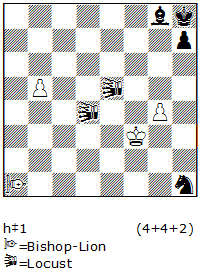
An interesting moment! Here, after 1. Sg3 the 1….nLOxg3-h2+? doesn’t work because of 2. nLOxg4-h4! Analogically: 1.Sf2 and now won’t work 1….nLOxf2-g1+? 2. nLOxb5-a5!
In the light problem No17 we can see a complex of motives: block of squares c1/d1, realized by the black Queen, Annihilation captures of pawns c6/g7, Zilahi theme, model mates. I. 1.Qxg7 2.Qg1 3.Qc1! nLOxf5-g5#; II. 1.Qxc6 2.Qh1 3.Qd1! nLOxe5-d5#. Our well-known special battery here is modified now, using the white pawn on the thematic line and a Kangaroo piece as a rear piece.
No.17. Petko A.Petkov
original
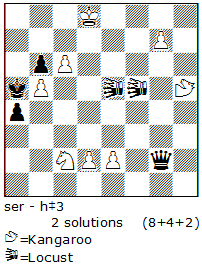
In the next, the 3rd part of this article, we’ll look at some other interesting batteries with Locusts!
To be continued…
How to..? Photo in comments

Short information by JuliasFairies.com:
How to add your photo to the comments at the site?
You can have your photo with your comment if you like. I believe that it would be nice! That’s how you can do it:
- To register at the site – use Guest Login Panel at the bottom of the right menu. Choose Register option. First of all you have to enter your username and email address. The password will come to the provided email address in a few seconds. Than you can use Login to sign-up with your username and password.
- After you’re logged in, you can see the “Howdy, your-username” at the top right corner of the page header. Move your mouse over it and you’ll see menu choices Edit My Profile and Log Out. Choose Edit My Profile to add your name, to change password and to add your photo (You can also send your photo to me – julia@juliasfairies.com – and I will add it to your profile myself).
- Of course, you can send comments without any registration. But if you register and use Login – your name (and photo if added) will be added to your comments automatically.



